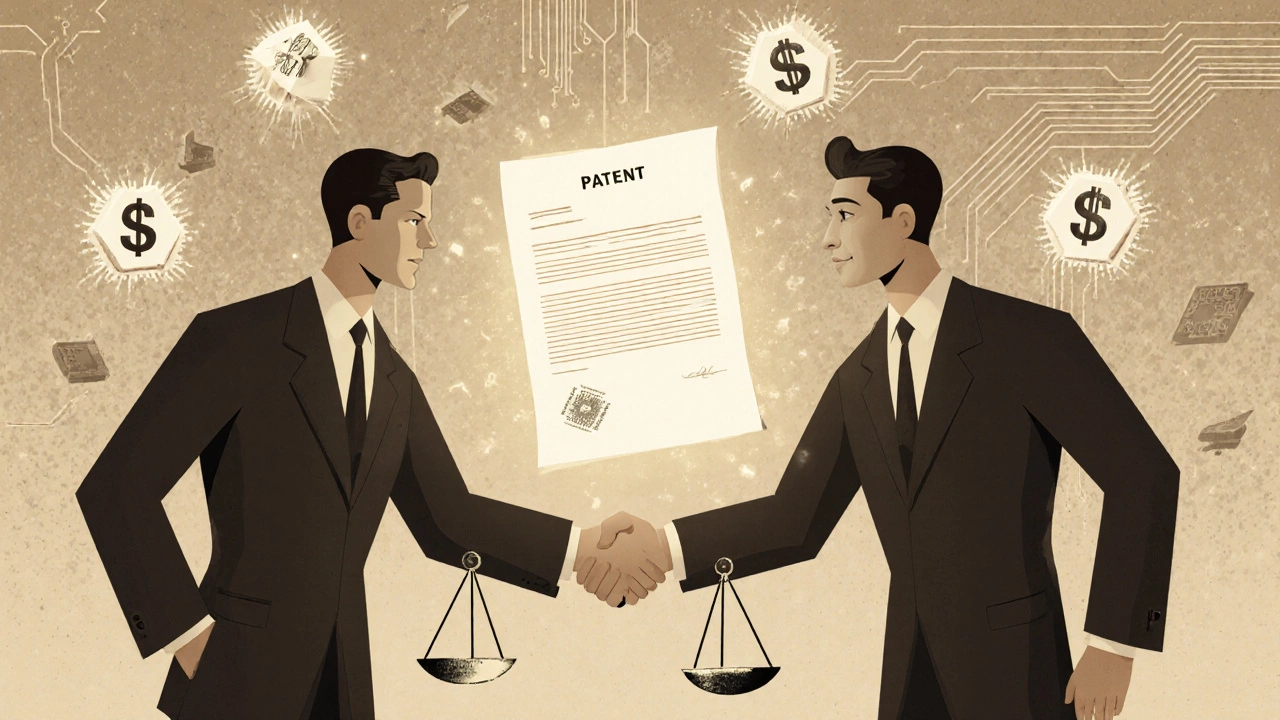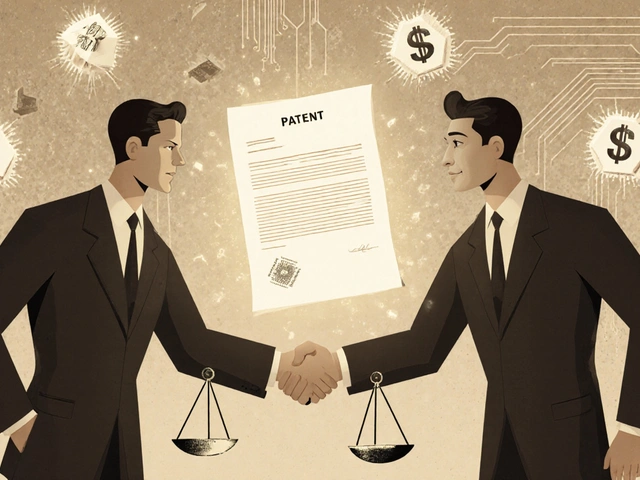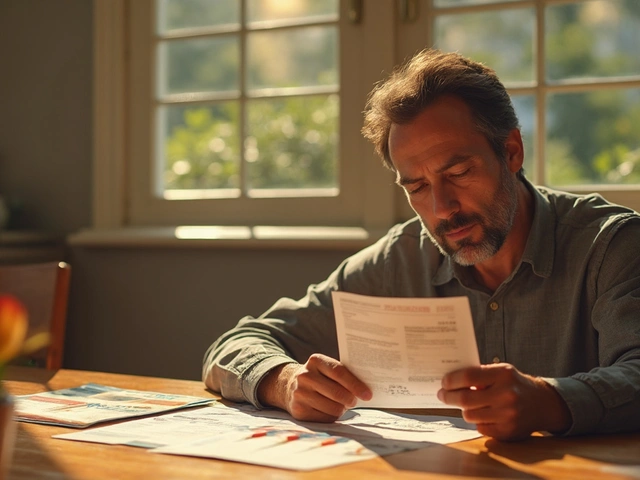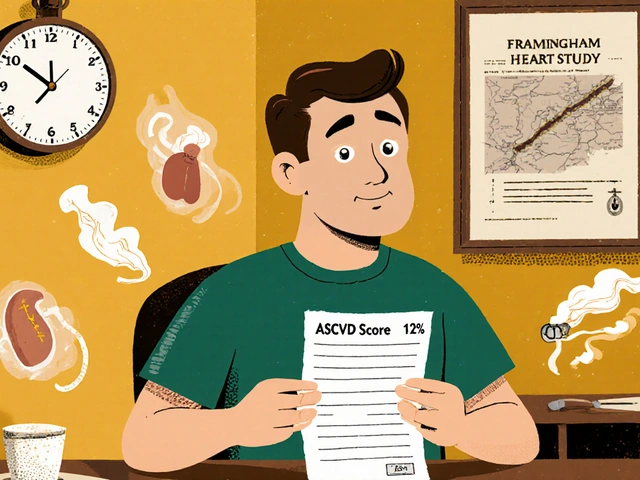When two big companies clash over a patent, they don’t always go to court. In fact, most of the time, they don’t. Over 85% of patent disputes in the U.S. end in settlement before a judge ever hears the case. That’s not luck. It’s strategy. Companies negotiate entry-not to avoid the fight, but to control it. They pick their battles, weigh the cost of winning versus losing, and often walk away with more than just money-they get access, collaboration, and market stability.
Why Settle Instead of Sue?
Patent lawsuits are expensive. Going to trial can cost between $3 million and $5 million, even for cases under $25 million in damages. That’s before you factor in lost time, distracted teams, and damaged relationships. For companies that make products, not lawsuits, that’s not a cost-it’s a risk. Settling lets them cut losses, avoid unpredictable juries, and keep their R&D teams focused on innovation instead of depositions. The real game isn’t about who owns the patent. It’s about who can afford to wait. Big players with thousands of patents-like Apple, Samsung, or Qualcomm-settle 89% of their disputes. Smaller companies? Only 63%. Why? Because the big ones have more to lose in court, but also more leverage. They can threaten countersuits, cross-license entire portfolios, or delay entry into markets. Settlement becomes a tool to manage risk, not just resolve it.The Anatomy of a Patent Settlement
A good patent settlement doesn’t just say, “Here’s $10 million.” It’s a detailed contract with layers. First, both sides pick which patents really matter. Usually, it’s 3 to 15 out of dozens. They build claim charts-detailed maps showing exactly how one product allegedly copies the patented tech. Then they test the patents’ strength. Are they valid? Could they be knocked out by old prior art? A 2021 USPTO study found nearly 40% of patents asserted in court were later invalidated. That’s why smart companies spend $150,000 to $300,000 before even sitting down to talk. They run what’s called a “patent portfolio stress test.” They dig into every patent’s weaknesses. If one’s shaky, they use it as leverage. “We’ll drop this one if you drop yours.” It’s poker with legal documents.How They Agree on Price
Royalties are the most common payment method. For standard-essential patents-tech like 4G or Wi-Fi that everyone needs-the rate is usually between 1.5% and 5% of product sales. But it’s not that simple. Ericsson and Samsung settled in 2021 with a $650 million upfront payment plus tiered royalties: 0.5% for low-end phones, up to 2.5% for premium devices. That’s not guesswork. It’s based on how much each patent contributes to the final product. Some deals use a “high-low” structure. This was popularized by Stanley Black & Decker in 2015. Both sides agree on two numbers: the most they’ll pay and the least they’ll receive. If the court rules in your favor, you get the high number. If you lose, you get the low. It removes the gamble. It’s used in 78% of cases between competitors-but almost never with patent trolls. Why? Because NPEs (non-practicing entities) don’t make products. Their goal isn’t fair value-it’s quick cash.Cross-Licensing: The Silent Winner
The smartest settlements aren’t about money at all. They’re about access. In telecom and semiconductors, 73% of disputes end in cross-licensing. Two companies agree: “You can use our patents, we’ll use yours.” No cash changes hands. Instead, they save millions on licensing fees and avoid future fights. Intel’s 2018 deal with MEDIATEK is a textbook example. Instead of paying royalties, they teamed up to co-develop 5G tech. The result? Over $200 million in combined R&D savings. That’s not a settlement. That’s a partnership born from conflict. But cross-licensing only works if both sides have strong portfolios. If one side has weak patents, the other won’t trade. That’s why valuation matters. Leading firms use “royalty stacking” models to make sure they’re not paying 15% of their product’s value just to cover every patent they’re using.The Role of Mediation and New Tools
Sometimes, a neutral third party helps. Mediation succeeds in 65% of patent cases. Former judges like Randall Rader-hired as mediators-bring credibility. In the Ericsson-Samsung case, Rader helped bridge gaps that lawyers couldn’t. He didn’t decide who won. He helped them see what both could live with. New tools are changing the game too. The USPTO’s Patent Evaluation Express (PEX) program lets companies get a non-binding validity opinion in weeks, not years-and at 60% lower cost. Already, 17% of new settlements use it. AI tools like PatentSight can scan millions of patents in days, finding prior art that humans miss. But they’re not perfect. A 2023 study showed AI still misses nearly 19% of key references. Human expertise still wins.
What Goes Wrong
Not every settlement works. The biggest mistake? Anchoring. If a company opens with an outrageous demand-say, $50 million when they expect $15 million-they often get more. A University of Chicago study found plaintiffs who ask for three times their target end up with 28% higher payouts. But that backfires if the other side walks away. Another trap: ignoring FRAND rules. If a patent is essential to an industry standard-like 5G-you can’t demand unfair terms. The European Commission fined Qualcomm €242 million in 2018 for using settlement pressure to block competitors. That’s not negotiation. That’s antitrust. And then there’s the complexity problem. In AI or quantum computing, one product might touch 500 patents across 10 countries. Negotiating that? It’s like solving a Rubik’s Cube blindfolded. WIPO says negotiation complexity has tripled in these fields.Who Wins in the Long Run?
The real winners aren’t the ones who collect the biggest check. They’re the ones who turn a fight into a future. Companies that settle early keep their teams productive. They avoid years of legal limbo. They build relationships. They innovate faster. The data shows it: 72% of corporate counsel say their first three patent settlements were worse than later ones. Why? Because they learned. They stopped thinking like litigators and started thinking like strategists. They stopped trying to crush the other side-and started trying to build something better together. The patent system isn’t broken. It’s just expensive. And the smartest companies don’t try to win every battle. They pick the ones worth fighting-and settle the rest.What percentage of patent disputes end in settlement?
Over 85% of patent disputes in the U.S. settle before trial, according to a 2022 Stanford Law School study of 10,000 cases from 2010-2020. This trend holds across industries, with large companies settling up to 89% of cases due to their ability to absorb litigation costs and leverage cross-licensing.
How much does a patent settlement typically cost?
Settlement values vary widely. Non-practicing entity (NPE) cases settle for a median of $1.2 million, while competitor disputes average $8.7 million. Royalty rates range from 1.5% to 5% of product revenue, and upfront payments can reach hundreds of millions, as seen in the Ericsson-Samsung $650 million deal. Legal and expert costs add another $3-5 million if litigation proceeds to trial.
What’s the difference between mediation and arbitration in patent disputes?
Mediation involves a neutral third party helping both sides reach a voluntary agreement-it succeeds in 65% of cases. Arbitration, on the other hand, results in a binding decision made by an arbitrator, resolving 81% of disputes but eliminating the right to appeal. Mediation preserves relationships; arbitration is faster but more final.
Why do big companies settle more often than small ones?
Large companies with over 1,000 patents have more to lose in court-not just financially, but in reputation and operational disruption. They also have stronger bargaining power through cross-licensing, countersuits, and access to legal teams that can run detailed validity analyses. Small firms often lack the resources to fight or negotiate effectively, making them more likely to lose or accept unfavorable terms.
What is a high-low settlement, and when does it work?
A high-low settlement sets two predetermined payment amounts: a minimum (low) and maximum (high) payout based on the outcome of a few key legal issues. It works best between competitors with mutual business interests-78% success rate-but fails in 92% of cases involving patent trolls, who seek quick payouts rather than long-term resolution.
How do FRAND rules affect patent settlements?
FRAND (Fair, Reasonable, and Non-Discriminatory) rules apply to patents essential to industry standards, like 5G or Wi-Fi. Companies holding these patents can’t demand excessive royalties or block competitors. Violations, like Qualcomm’s €242 million fine from the European Commission in 2018, can lead to antitrust penalties. Settlements involving SEPs must reflect these limits, making negotiations more structured and transparent.
Are AI tools reliable for patent settlement preparation?
AI tools like PatentSight can cut patent analysis time from weeks to days and identify potential prior art quickly. However, a 2023 study in Nature Machine Intelligence found they still miss 18.7% of relevant references compared to human experts. They’re useful for speed and scale, but not replacement for experienced patent attorneys and technical specialists.
What’s the future of patent settlements?
The future points toward automation and integration. Blockchain-based smart contracts are being piloted by IBM and Microsoft to automatically adjust royalty payments based on real-time sales data, potentially cutting post-settlement disputes by 35-40%. The Unified Patent Court in Europe has already increased cross-border settlements by 22% since 2023. As technologies like AI and quantum computing create patent thickets with hundreds of overlapping claims, settlements will need to become more modular, global, and dynamic.






